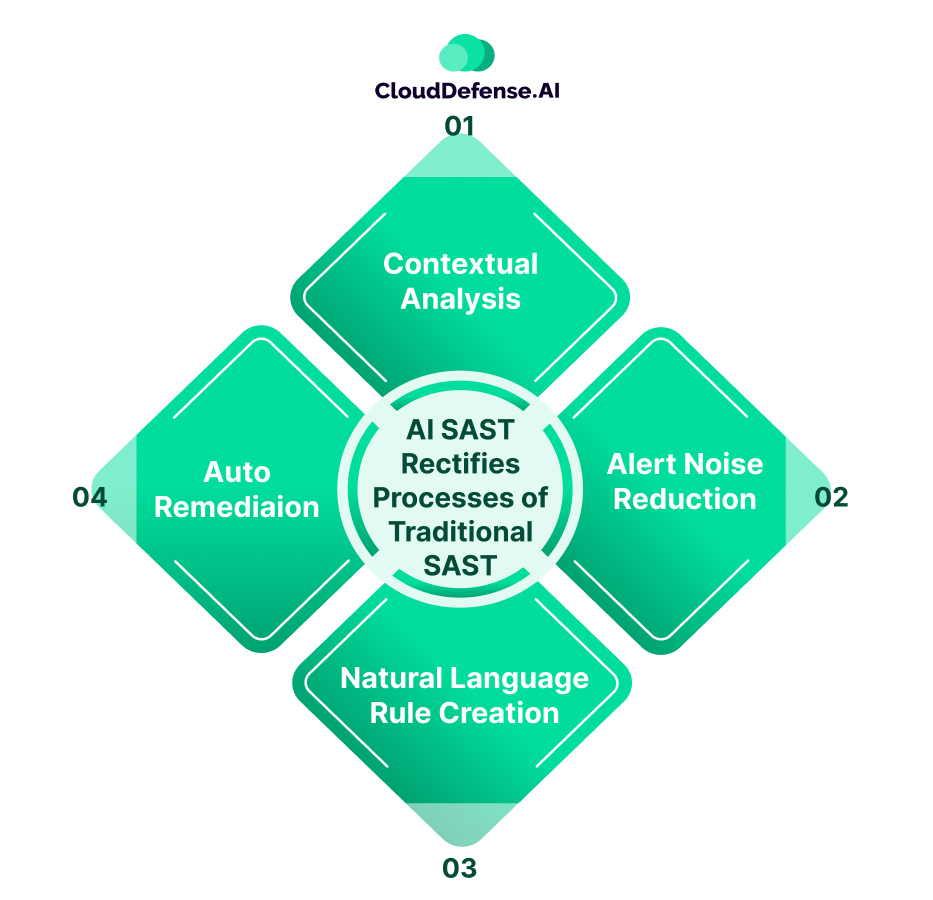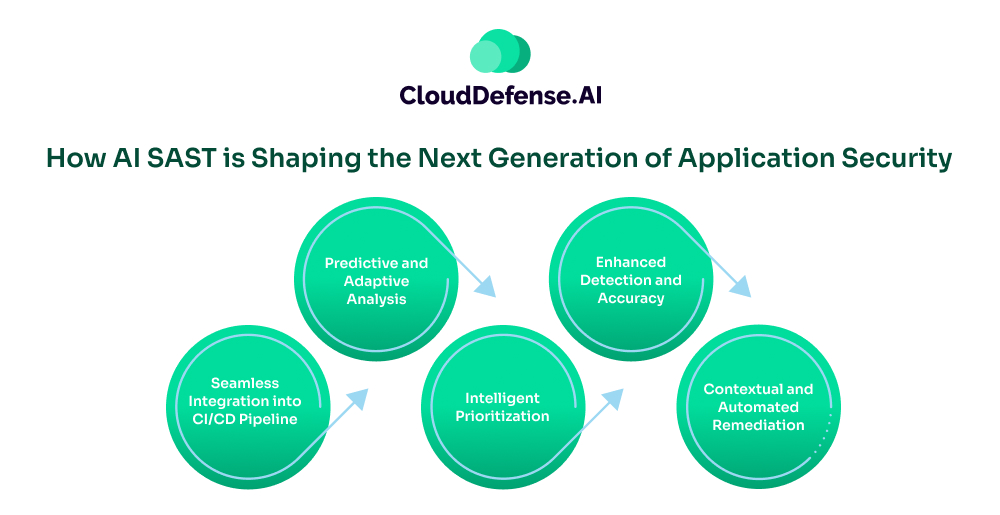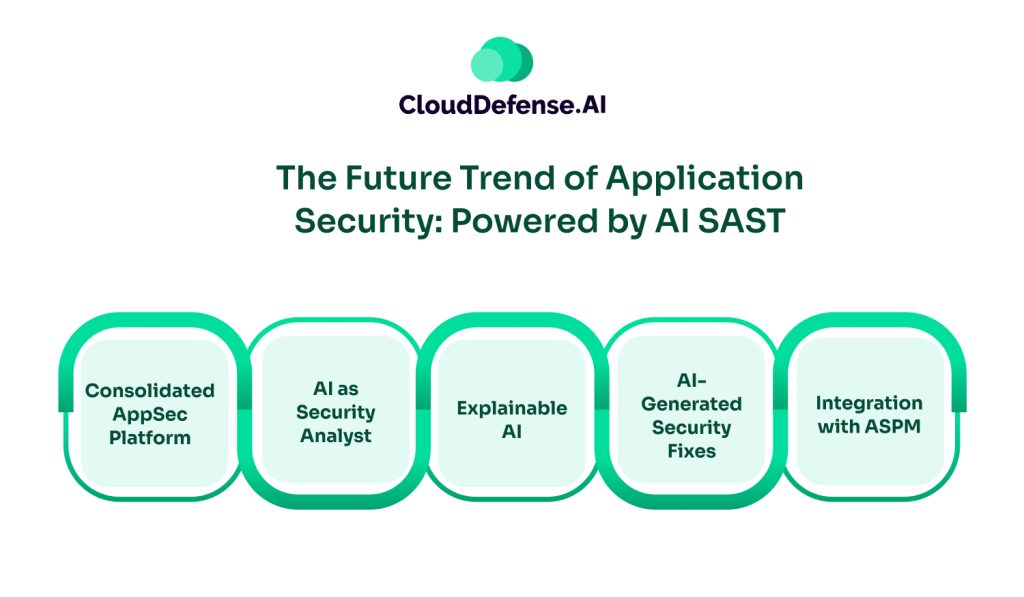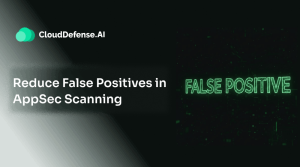Modern software development commands speed and agility, fueled by AI-assisted coding and an advanced CI/CD pipeline. However, to cater to high-speed application development approaches, organizations need a shift in their application security approach.
AI SAST, or AI-based Static Application Security Testing, serves as a proactive and intelligent tool that is reshaping the way organizations approach their application security. It is a leap towards a smart and transformative AppSec approach that secures every aspect of SDLC.
This article highlights how AI SAST is shaping modern application security and what it has on offer for the future.
AI SAST: Shift Toward Proactive Security
Traditional SAST has been the cornerstone of application security, leveraging static pattern matches and rule-based analysis techniques to identify vulnerabilities. However, in today’s fast-paced application development, where speed is top priority, standard SAST is falling behind.
Importantly, it is unable to detect complex and logic-based threats and zero-day vulnerabilities while producing high false positives. AI SAST has transformed everything by leveraging artificial intelligence, LLM, and machine learning to proactively identify security threats.
It not only uncovers security threats but also intelligently prioritises alerts and automates the remediation process. AI has significantly enhanced the capability of SAST as it helps it to understand the context of the code and identify semantic and business logic vulnerabilities.
Unlike SAST, which takes a reactive approach, AI SAST takes a proactive approach where it identifies vulnerabilities in source code or its dependencies before they are committed. It integrates directly into the CI/CD pipeline and enables organizations with context-aware vulnerability detection that helps in keeping pace with DevOps.
How AI SAST Rectifies Processes of Traditional SAST

The integration of AI, along with ML and LLMs, has completely redefined the working of SAST. Modern AI SAST, like QINA Clarity AI, rectifies all the shortcomings and provides users with:
- Contextual Analysis: Unlike standard SAST, which uses a rule-based approach, AI SAST analyses how the code interacts with other components. Based on the interaction and business logic, it identifies vulnerabilities.
- Alert Noise Reduction: The integration of AI and ML has drastically improved the alert prioritisation process. AI and ML are continuously learning from live data streams and developers’ feedback, reducing false positives drastically.
- Natural Language Rule Creation: AI SAST with integration of other security tools enables teams to establish security policies using natural language. QINA Clarity with Pulse allows the team to ditch DSLs and create policies using plain English.
- Auto Remediation: AI SAST tools with Generative AI models enable the tool to provide context-aware code remediation, minimizing manual debugging time. Based on the vulnerability, it also gives developers the option to automate the remediation process.
How AI SAST is Shaping the Next Generation of Application Security

With the integration of AI, ML, and LLMs, AI SAST is shaping the next generation of application security. It is providing organizations with a smart, highly accurate, automated, and developer-friendly solution.
Here is how AI SAST is revolutionising application security:
- Predictive and Adaptive Analysis: AI SAST isn’t only proactive but also predictive. It is continuously learning from historical and data streams. The tools also utilize machine learning to predict probable vulnerable code segments and provide remediation suggestions before the code is committed. AI SAST also leverages behavioural analytics and smart triage to learn from numerous commits and predict new threat patterns.
- Enhanced Detection and Accuracy: AI SAST is trained on a vast codebase, frameworks, securing coding practices, and vulnerabilities. Most importantly, to identify vulnerabilities, understand the context of the code, and analyse the data and control flow within the application. It helps the tool to uncover nuanced and zero-day vulnerabilities, including business logic flaws. This tool is crucial for identifying vulnerabilities that often arise from AI-generated code, which traditional tools might miss.
- Seamless Integration into CI/CD Pipeline: AI SAST is designed to establish a shift-left approach in the SDLC by integrating seamlessly into the CI/CD pipeline. It enables the tool to integrate security early in the development cycle and automatically scan code before every code commit. Modern AI SAST, like QINA Clarity AI, integrates directly into the IDE so that it can provide security feedback to developers as they write code. The convergence of AI DAST through specific platforms also enables customers to establish shift-left and shift-right loops and reshape the application security strategy.
- Intelligent Prioritization: One of the major advancements that AI SAST has brought to application security is intelligent prioritization. Not all the security findings are impactful and exploitable. AI SAST analyses security findings based on their exploitability, data flow, data sensitivity, business impact, and location in the application. Based on all the factors, it prioritises the risks and allows DevSec teams to focus on the most crucial threat first. QINA Clarity AI takes one step further, where all security finding goes through a 4-stage analysis to filter out false positives and present risk with a severity rating.
- Contextual and Automated Remediation: AI SAST has completely revolutionized how organizations approach remediation while building an application security strategy. When a vulnerability is detected, it provides developers with actionable and context-aware remediation guidance directly into the IDE. Some tools, like AI SAST, also provide code snippets and step-by-step specific guidance to solve the vulnerability. These tools, by integrating QINA Pulse, also enable developers to generate automated fixes through simple English commands. QINA Pulse is an AI agent for AppSec that streamlines the remediation workflow for developers.
The Future Trend of Application Security: Powered by AI SAST

The integration and evolution of AI SAST in application security has just started, and it is shaping the future security approach in a whole new way. The future of AppSec lies in the integration with AI to achieve agile and fast-paced development while maintaining security and integrity.
The addition of AI SAST in application security will bring forward many new, sophisticated trends:
- Consolidated AppSec Platform: With AI being integrated into SAST, it is expected that the application security test tool will merge with other AppSec tools for a holistic approach. Modern AppSec platforms will fuse AI SAST, AI DAST, IaC Scanning, and SCA into one to manage risks across the SDLC.
- AI as Security Analyst: AI is gradually enhancing its capabilities and will soon augment the intelligence of security analysts. The synergy of AI security analysis with AI-powered SAST will create a powerful bond that will help developers automate most application security tasks. It will also provide the teams with more insight that will help them to overcome complex and nuanced security issues.
- Explainable AI: With Explainable AI getting more prominent, the integration with AI SAST will make it more impactful and trustworthy. It will not only help the AI SAST to provide remediation guidance but will also provide explanations behind an identified vulnerability and the remediation process taken. It will help developers to learn more about new trends in security threats and how they can practice coding securely.
- AI-Generated Security Fixes: Soon, modern AI-based SAST tools will automatically generate fixes based on the vulnerability and apply the code remediation. It will not only go beyond automating common fixes but also automate the remediation workflow for zero-day vulnerabilities. This will not only accelerate the remediation process and help teams to minimize the attack vectors.
- Integration with ASPM: In the near future, AI SAST will work in synergy with ASPM and the AIOPs ecosystem to provide DevSec teams a complete view across code and infrastructure. It will provide comprehensive risk management and make the AI SAST a key part of modern application security orchestration.
Conclusion
AI SAST is the future of application security, and it is evolving rapidly to make applications more secure against modern security threats. As organisations accelerate their software development process, AI SAST will play a crucial role in helping the team to maintain it while ensuring optimum application security.
AI SAST tools like QINA Clarity AI with Pulse are a necessity for modern organizations as it is scalable, intelligent, and will help in automating the remediation workflow. The future of application security is more proactive and will help developers navigate many complex security challenges.
With integration of AI-based SAST, organizations can completely embrace DevSecOps- embedding security into every phase of development. The adoption will ensure that the future of application security is not only proactive but also more secure.







